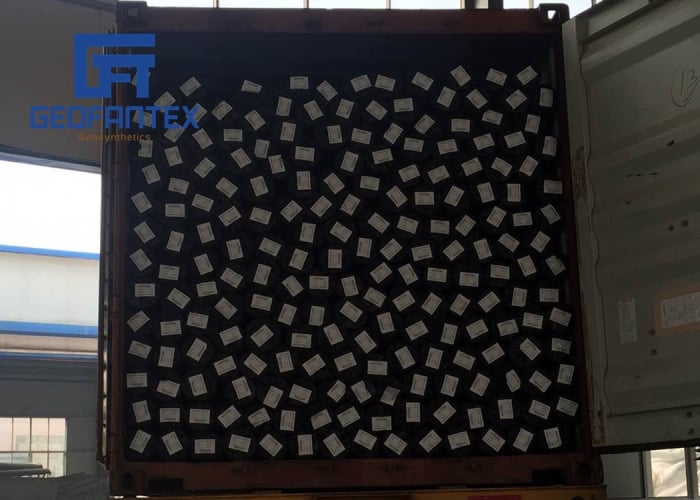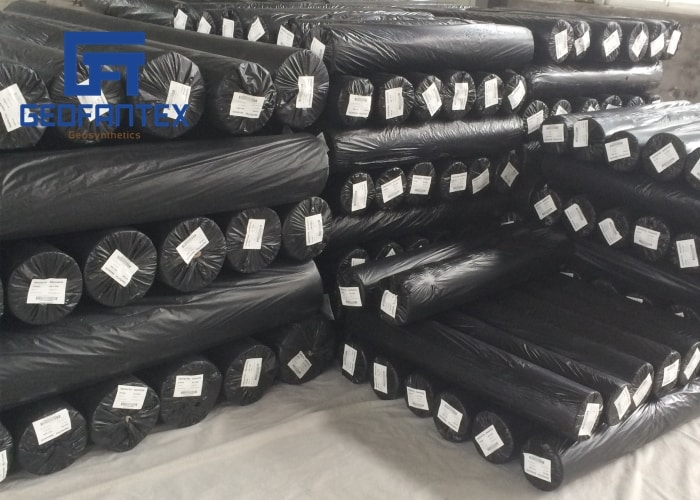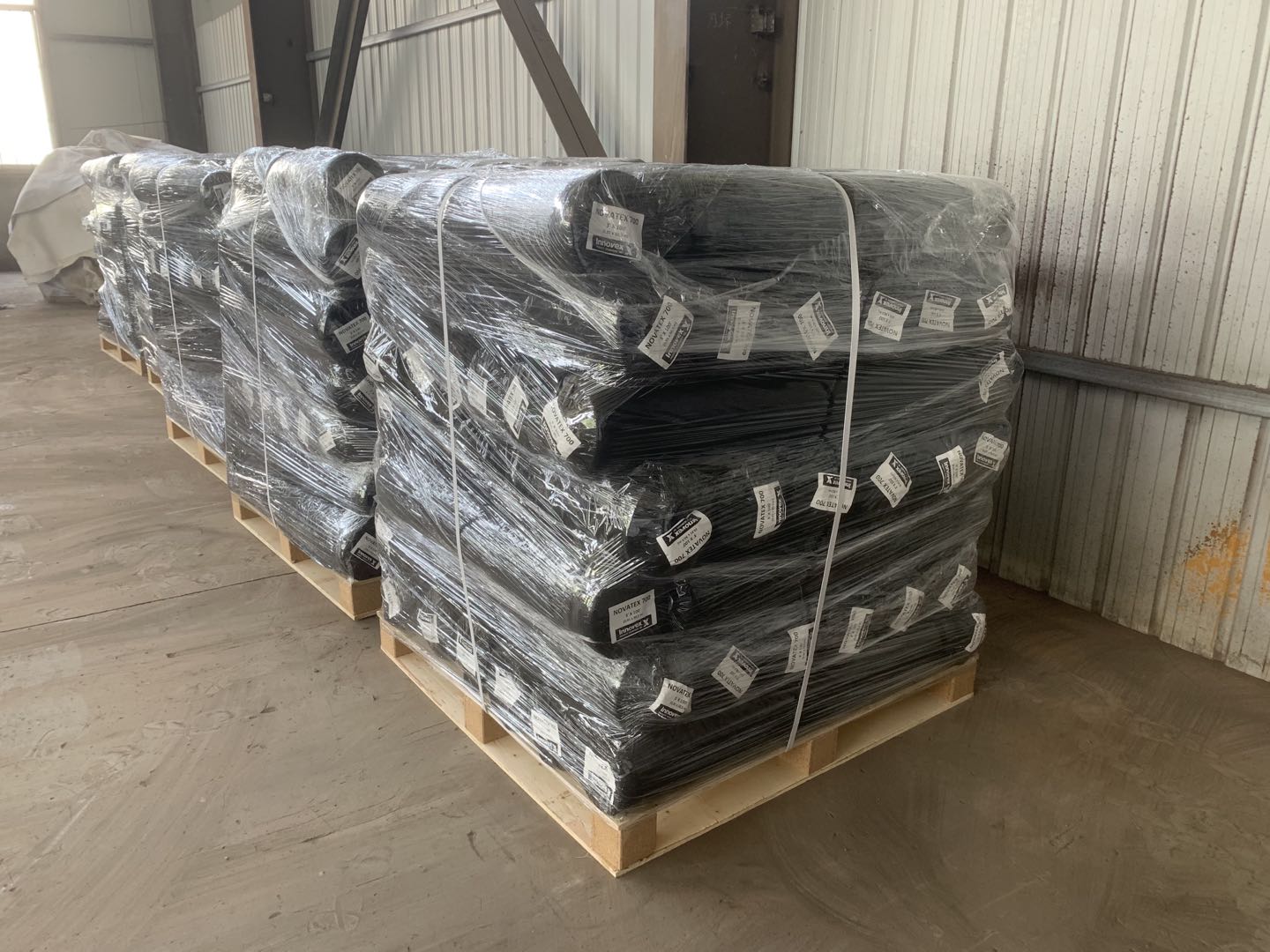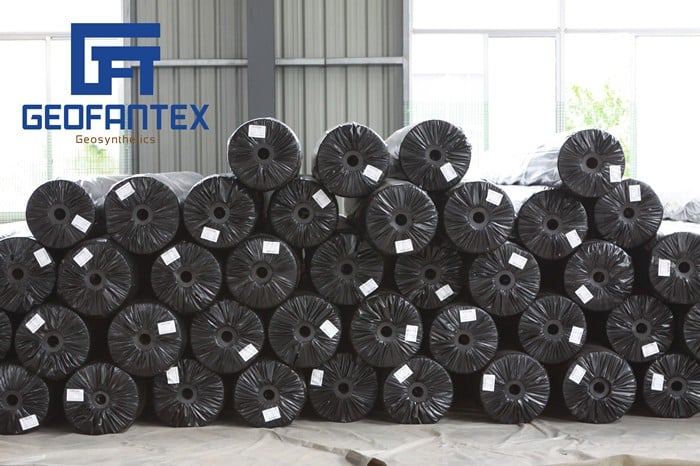Can I use Landscape Fabric for Erosion Control? – Geofantex
- Brand GeoFanTex® GFE GFS GFP
- Product origin China
- Delivery time 7-14 days
- Supply capacity 40′ HQ/ 7 Days
Product Details
The Features of Landscape Fabric
- It is made of polymer materials, with superior performance, strong shading rate, high strength, non-toxic and environmentally friendly, and long service life.
- Good air permeability and strong water permeability, play very good heat preservation and moisture retention, which is conducive to crop growth [1].
- Resistant to pulling, strong toughness, reducing damage caused by traction during construction and maintenance.
- Inhibit pests and reduce the damage of pests to crop roots.
Polyester Staple Fiber(GFS), Polyester Continuous filament(GFE) and Polypropylene Staple fiber(GFP) nonwoven geotextile have main functional mechanical properties, permeable or impermeable properties, soil-tightness. The rolls are easily installed and conformed to the ground or trench surface. The rolls are strong enough to withstand severe installation stresses yet exhibit great permeability chemically resistant to naturally occurring acids and soil alkalis, providing good solutions to many building, plumbing, and engineering applications.
(* Geofantex Geosynthetics can produce GeofanTex® according to your requirement in constructions, MINIMUM ORDER QUANTITY: 20’ft Container)
Geotextile Speicifciations
| Material | Polyester Staple Fiber(GFS) Polyester Continuous filament(GFE) Polypropylene Staple fiber(GFP) |
| Width | 0.2m to 1.0m, could be customized |
| Length | Could be customized |
| Gram | Any gram, normally 130g/m2 – 150g/m2 |
The Applications of Landscape Fabric
- Before use, level the soil, loosen the soil, and irrigate, and treat surface weeds, gravel, soil and other debris; so that the weed-proof cloth that is laid is tightly attached to the ground;
- When laying, place the wed-proof cloth rolls neatly, the plane is upward, and the raised side with a little pattern is down to the ground. The wed-proof cloth is completely attached to the ground, and the ground is completely covered in the direction to ensure that the laying is flat and not left. The gap, without excessive folds, was later used to cover the overlap and both sides of the grass-proof cloth with soil (or special ground nails);
- Maintenance instructions: In the later stage, check the ground cloth from time to time to prevent soil erosion of the covering or loosening of the fixing nails, which will affect the effect of weed control and the service life. Grasscloth to avoid corrosion damage.
Geofantex Geosynthetics have to make a series of guarantee for our products both plant processing and selling out to our customers. The selling to you is the first step, the service, and guarantee is our task. Geofantex Geosynthetics have an ISO Certificate to guarantee the raw material, the product processing, and the end product. From receiving your order to replacement and installation of the products, we have solved the problems in time if you need, whatever the quality and technics guideline or suggestions. Our company has been committed to supplying high-quality products with reasonable price and delivery in time.
MANUFACTURING QUALITY ASSURANCE
GEOFANTEX has an on-site Manufacturing Quality Assurance Laboratory at factory. GEOFANTEX maintain a high level of quality and up-to-the-minute results on finished products through a fully equipped, well staffed, dedicated laboratory existing in each of the manufacturing facilities. Each facility follows the same guidelines for evaluating the quality of GEOFANTEX products and is capable of adapting to market-driven requirements.
A. Objective
The objective of the GEOFANTEX Quality Assurance program is to define implementation of basic manufacturing quality assurance (MQA) procedures necessary to ensure consistent production of quality products supplied to the geosynthetic market. Note that at this time, these procedures are limited to polypropylene staple fiber nonwoven geotextile.
B. Scope
In order to achieve GEOFANTEX’s stated purpose, a rigorous set of minimum standards and an effective test program to assure compliance has been established. These procedures and requirements are frequently reviewed and adjusted to assure compliance with current market demands and/or predetermined project specifications. These procedures assure that raw materials and process parameters are controlled to provide products complying with GEOFANTEX’s pre-defined minimum characteristics.

PRODUCT IDENTIFICATION AND DOCUMENTATION
A. Roll Numbering
Each roll of geotextile is assigned a unique roll number. The Quality Assurance Laboratory maintains records documenting the raw materials and resulting product quality information.
B. Approval Procedure
Results for each tested roll of product are checked against both GEOFANTEX 、China standard and customer specifications for compliance. The Quality Assurance Laboratory approves those materials that meet these requirements for shipment.
C. Non-Conformance
Material that does not meet GEOFANTEX minimum standards is given a roll number, but is rejected and not placed into inventory. The material is identified as scrap and will not be utilized. Material that meets GEOFANTEX minimum standards but does not meet a stricter customer specification is not allocated to that customer, but is placed into inventory as GEOFANTEX standard material.
D. Documentation
Individual Quality Assurance Certificates are generated and supplied for each roll of needle punched nonwoven geotextile product to include all relevant quality assurance information about the material(s).
Geofantex Geosynthetics have a series of package and delivery service working procedures. Geofantex Geosynthetics have supply thousands of containers to Latin America, North America, Southeast Asia and developed countries and Africa within the past ten years. We provide the package of products with the rolls, pots, bags, sheets, or your requirement in orders. Our company has been committed to supplying high-quality products with reasonable price and delivery in time. Delivery one 40’HQ within 7 – 10 days. And we have an obligation in increasing loading quantity and make you save the freight costs maximally. We supply the products by plane, by sea and land carriage to any regions or any countries of the worldwide, even the door-to-door service.
| SEPARATION | REINFORCEMENT | FILTRATION | DRAINAGE | WATERPROOF | PREVENTION | POLLUTION PREVENTION | PROTECTION | CONSOLIDATE | |
| GEOTEXTILE | √ | √ | √ | √ | √ | √ | |||
| GEOMEMBRANE | √ | √ | √ | ||||||
| GEOGRID | √ | √ | |||||||
| GEONET | √ | ||||||||
| GEOTUBE | √ | ||||||||
| GEOCELL | √ | √ | |||||||
| GCL | √ | √ | |||||||
| GEOCOMPOSITE | √ | √ | √ | √ | √ | √ | √ | ||
| GEOCONCRETE BLANKET | √ | √ | √ | ||||||
| Drainage Board B | √ | √ | √ | √ | |||||
| Storage and Drainage Board | √ | √ | √ | √ | |||||
| Grass Paver | √ | √ | √ | √ | √ | √ | √ | ||
| Macmat | √ | √ | √ | √ | √ | √ | √ | ||
| GeoFanTex®GD 2L | √ | √ | √ | √ | √ | √ | |||
| GeoFanPipe® FP | √ | ||||||||
| GeoFanDrain® BC | √ | √ | √ | ||||||
| GeoFanPipe® DCP | √ | √ |
What is Landscape Fabric
Landscape Fabric, also called weed mat textile, is a non-woven fabric used in the field to prevent weeds from growing. Black landscape fabric can effectively prevent sunlight from shining through the ground to the weeds below, control the photosynthesis of the weeds, and thus control the weeds. Growth. Landscape Fabric is mostly used in garden seedlings, flowers, orchards (strawberry, fig, dragon fruit, etc.), Chinese herbal medicine planting, greenhouses and other fields for weeding. The use of environmentally friendly materials and the addition of polymer functional materials are degradable, pollution-free, and will not cause white pollution. It is a safe choice for green organic agriculture
Development history of the Geofantex
Company Profile
Geofantex Geosynthetics Co., Ltd. is located in the beautiful coastal city of Dalian, with superior geographical location, convenient transportation, and developed communications. The company was founded in 2014 with a registered capital of 5,000,000 yuan. It has an industrial park covering an area of more than 50 acres in Jinan, Shandong. It has a modern office environment, advanced production equipment, and a group of high-quality and professional technical and management personnel.
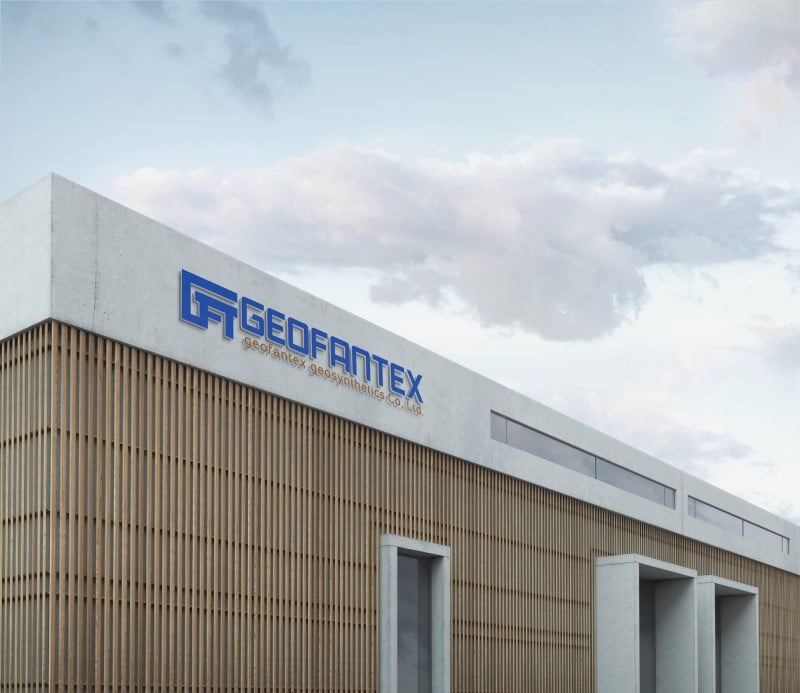
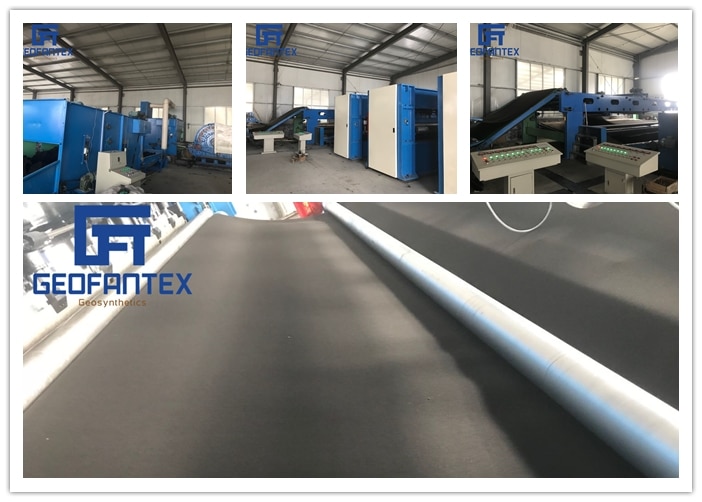
The company gives full play to its own innovation advantages, platform advantages, and market advantages, and with the support of national policies, builds a national first-class enterprise, always follows the principle of “quality first, reputation first”, adhering to the principle of “people-oriented, quality for survival, integrity, unity and hard work”, Integrated enterprise spirit, sincere cooperation with various engineering units and colleagues from all walks of life, harmonious development, and work together to make greater contributions to infrastructure.
Frequently Asked Questions
Get Free Sample
We’ll respond as soon as possible(within 12 hours)
Nonwoven Landscape Fabric stabilizing hillside
A couple of years ago our neighbors built a new home on their property and had concerns that their hillside would erode with all the heavy winter rains during construction. They decided to put down landscape fabric to help mitigate the erosion, but wondered if landscape fabric is best solution for helping prevent erosion.
Geotextile Landscape Fabric can help mitigate soil erosion. Its most effective when buried under 4 inches of soil and used on slopes with 4:1 or less grade. 4:1 slope is 1’ of elevation for every 4’ of distance. Other products like Erosion Control Blankets or Turf Reinforcement Mats are better suited for higher sloped areas.
In this article we’ll cover where erosion control fabric is best used for erosion control, and also when its not appropriate, and what other materials should be considered for various scenarios.
How does Landscape Fabric help prevent erosion?

Landscape fabric helps stabilize soil and provides a layer of protection against erosion. The fabric is laid out over the slope/hillside and soil or aggregate is placed on top. Sandwiching the fabric between soil helps prevent water from easily washing away the slope and enables a secure place for grass and vegetation to grow. Erosion fabric is best suited for applications on gradual grades.
Roadside being covered with Fabric to help prevent erosion
Erosion Control Fabric – 8 oz Non Woven
Landscape fabric helps prevent erosion by both stabilizing the hillside against erosion from rains, and also by providing time and space for grasses and vegetation to grow. Fabric plays a supporting role in this process and can be extremely helpful and easy to implement if your developing a landscape that will withstand erosion. The greater the slope of the hillside the more likely it will be that other erosion control solutions are required. In general the steeper the hillside or slope the harder it is for grasses and vegetation to fill in and take root. Ground cover and grasses are an import aspect in preventing erosion as the root network of these plants will stabilize the soil and help water from causing further damage.
What is the best type of Landscape Fabric for Erosion Contdrol?
There are two primary geotextiles used for landscaping, Woven Fabric and Nonwoven fabric. Each are useful and are designed with different applications in mind. In general woven geotextile fabric is used where you need a lot of strength and don’t require as much drainage (permeability). Alternatively Nonwoven fabric also called drainage fabric is ideal for…
Common Nonwoven Fabric Applications
- Hillside Stabilization & Erosion Control
- French drains, and/or drainage fields
- Rip rap, shorelines, retaining walls
- Pond and water feature construction

Nonwoven Fabric
Common Woven Fabric Applications
- Aggregate or paved driveway stabilization
- Under patios or hardscaping
- Roads, highways, and parking lot construction
- Ground Cover

Woven Geotextile Fabric
Landscape Fabric vs. slope of the hillside
Here is an example photo of various grades. Starting at a gradual grade and moving down to 2:1 (50%) slope. understanding your slope is important for knowing if you should be utilizing Erosion Control Fabric or potentially using something else.
For slopes greater than 4:1 grade, other erosion solutions such as Erosion Control Blankets (ECBs), or Turf Reinforcement Mats (TRMs) are going to be a more appropriate solution. See below for more information on ECB and TRM products.
PRO TIP:
Slopes over 4:1 grade (25%) are NOT suitable for Landscape Fabric
Visual representation of hill slope
Erosion Control product options
Here are 3 things to consider in order to determine if you need to look at other erosion control solutions.
- Slope – Is the slope greater than 4:1? If yes, then use an Erosion Control Blanket (ECB) or Turf Reinforcement Mat (TRM).
- Amount of Rainfall – Is my area known for heavy rain or flash flooding? If yes, then consider using ECB or TRM products.
- Intended Project Duration – Is this a temporary or permanent solution? Depending on the project needs you can consider biodegradable options, or synthetic/permanent options as dictated by the project engineer. See chart below for project expected timelines:
Other Erosion Control Products:
Erosion Control Blankets
An erosion control blanket consists of a matrix of material such as coconut, straw, or wood fiber, that is held together by natural or synthetic fibers. The most common natural fiber used is straw and coconut fiber also known as coir. These fiber blankets are designed to slow the flow of water and provide a place where seed can grow and re-vegetate the landscape. Many blankets are considered shorter term with 1-2 years of effective life. These units are typically staked down on hillsides and designed to degrade while providing enough protection for grass seed to grow up through the fibrous matrix. When the blankets fully degrade you’re left with the vegetation that will help hold the soil in place. You can find the full collection of Erosion Control Blankets here >
How to Apply Erosion Control Fabric
Installation is not complicated and can be done over a weekend with a bit of work following these steps:
Installing the Landscape Fabric in 3 steps
- Lay out fabric on slope
- Pin fabric down with 6″ landscape pins
- apply 4-6 inches of soil/aggregate on top of fabric
Conclusion
Hillside erosion can be frustrating to deal with, but using Landscape Fabric can help stabilize the soil and provide time for grasses and local vegetation to take root. vegetation root networks are crucial to keeping your hillside from further erosion. If the area you are working is fairly steep, or gets a lot of rain then other products like Erosion Control Blankets or Turf Reinforcement Mats will be a better for your project.


